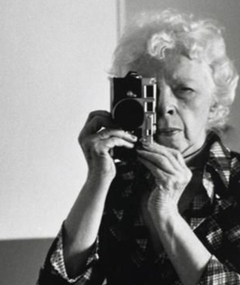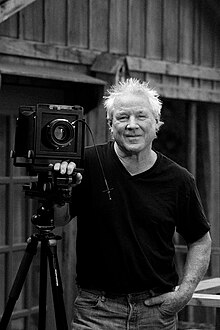
Ansel Easton Adams was an American landscape photographer and environmentalist known for his black-and-white images of the American West. He helped found Group f/64, an association of photographers advocating "pure" photography which favored sharp focus and the use of the full tonal range of a photograph. He and Fred Archer developed a system of image-making called the Zone System, a method of achieving a desired final print through a technical understanding of how the tonal range of an image is the result of choices made in exposure, negative development, and printing.

Group f/64 or f.64 was a group founded by seven American 20th-century San Francisco Bay Area photographers who shared a common photographic style characterized by sharply focused and carefully framed images seen through a particularly Western (U.S.) viewpoint. In part, they formed in opposition to the pictorialist photographic style that had dominated much of the early 20th century, but moreover, they wanted to promote a new modernist aesthetic that was based on precisely exposed images of natural forms and found objects.

Edward Henry Weston was an American photographer. He has been called "one of the most innovative and influential American photographers" and "one of the masters of 20th century photography." Over the course of his 40-year career Weston photographed an increasingly expansive set of subjects, including landscapes, still lifes, nudes, portraits, genre scenes, and even whimsical parodies. It is said that he developed a "quintessentially American, and especially Californian, approach to modern photography" because of his focus on the people and places of the American West. In 1937 Weston was the first photographer to receive a Guggenheim Fellowship, and over the next two years he produced nearly 1,400 negatives using his 8 × 10 view camera. Some of his most famous photographs were taken of the trees and rocks at Point Lobos, California, near where he lived for many years.
Wynn Bullock was an American photographer whose work is included in over 90 major museum collections around the world. He received substantial critical acclaim during his lifetime, published numerous books and is mentioned in all the standard histories of modern photography.

Cole Weston was photographer Edward Weston's fourth and youngest son. Although Weston "was born into the tradition of craftsman-produced black-and-white art photography, he was to find his own photographic direction in colour.".

Theodore Brett Weston was an American photographer.

Lisette Model was an Austrian-born American photographer primarily known for the frank humanism of her street photography.
John Sexton is an American fine art photographer who specializes in black and white traditional analog photography.
Linda Connor is an American photographer living in San Francisco, California. She is known for her landscape photography.

Barbara Morgan was an American photographer best known for her depictions of modern dancers. She was a co-founder of the photography magazine Aperture.

Sonya Noskowiak was a 20th-century German-American photographer and member of the San Francisco photography collective Group f/64 that included Ansel Adams and Edward Weston. She is considered an important figure in one of the great photographic movements of the twentieth century. Throughout her career, Noskowiak photographed landscapes, still lifes, and portraits. Her most well-known, though unacknowledged, portraits are of the author John Steinbeck. In 1936, Noskowiak was awarded a prize at the annual exhibition of the San Francisco Society of Women Artists. She was also represented in the San Francisco Museum of Art’s “Scenes from San Francisco” exhibit in 1939. Ten years before her death, Noskowiak's work was included in a WPA exhibition at the Oakland Museum in Oakland, California.

Johan Hagemeyer was a Dutch-born horticulturalist and vegetarian who is remembered primarily for being an early 20th century photographer and artistic intellectual.
Henrietta Mary Shore was a Canadian-born artist who was a pioneer of modernism. She lived a large part of her life in the United States, most notably California.
Carol Henry is an American fine art photographer and curator.

Morley Baer, an American photographer and teacher, was born in Toledo, Ohio. Baer was head of the photography department at the San Francisco Art Institute, and known for his photographs of San Francisco's "Painted Ladies" Victorian houses, California buildings, landscape and seascapes.

Dody Weston Thompson was a 20th-century American photographer and chronicler of the history and craft of photography. She learned the art in 1947 and developed her own expression of “straight” or realistic photography, the style that emerged in Northern California in the 1930s. Dody worked closely with contemporary icons Edward Weston, Brett Weston and Ansel Adams during the late 1940s and through the 1950s, with additional collaboration with Brett Weston in the 1980s.
Margaret Woodward Weston, known as "Maggi", is an American photography collector and promoter who started one of the first commercial art galleries in the United States devoted solely to photography.
Kate Breakey is a visual artist known for her large-scale, hand-colored photographs. Since 1981 her work has appeared in more than 75 solo exhibitions and more than 50 group exhibitions in the United States, France, Japan, Australia, China, and New Zealand. Her work is in the permanent collection of many public institutions including the Center for Creative Photography in Tucson, the Museum of Photographic Arts in San Diego, the Museum of Fine Arts, Houston, the Wittliff collections at Texas State University, the Austin Museum of Art, the National Gallery of Australia in Canberra and the Osaka Museum in Japan. In 2004, she received the Photographer of the Year Award from the Houston Center for Photography.
Sandra S. "Sandy" Phillips is an American writer, and curator working in the field of photography. She is the Curator Emeritus of Photography at the San Francisco Museum of Modern Art. She joined the museum as curator of photography in 1987 and was promoted to senior curator of photography in 1999 in acknowledgement of her considerable contributions to SFMOMA. A photographic historian and former curator at the Vassar College Art Gallery in Poughkeepsie, N.Y., Phillips succeeded Van Deren Coke as head of one of the country’s most active departments of photography. Phillips stepped down from her full time position in 2016.
Holly Roberts is an American visual artist known best for her combination of photography and paint. “Holly Roberts caused a stir in the fine art photography world of the eighties by fusing painting and photography, painting directly onto photographs”. Roberts lives and works in Corrales, New Mexico. Her work is in the permanent collection of several museums in the United States.











